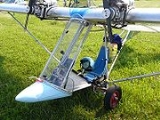
Ultraflight Lazair
Encyclopedia
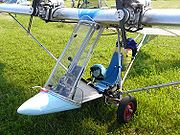
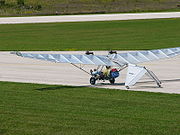
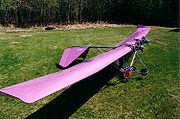
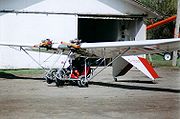
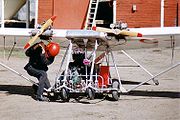
Canada
Canada is a North American country consisting of ten provinces and three territories. Located in the northern part of the continent, it extends from the Atlantic Ocean in the east to the Pacific Ocean in the west, and northward into the Arctic Ocean...
designed and built twin-engine ultralight aircraft
Ultralight aircraft (Canada)
The Canadian Aviation Regulations define two types of ultralight aircraft: basic ultra-light aeroplane , and advanced ultra-light aeroplane .- Canadian definition of ultra-light :...
that were sold in kit form between 1979 and 1984.
With a total production of over 2000 aircraft delivered the Lazair series is the most produced Canadian-designed aircraft.
Development
The designer of the Lazair, Dale Kramer, was an aeronautical engineering student at the University of TorontoUniversity of Toronto
The University of Toronto is a public research university in Toronto, Ontario, Canada, situated on the grounds that surround Queen's Park. It was founded by royal charter in 1827 as King's College, the first institution of higher learning in Upper Canada...
when he attended the Oshkosh EAA
Experimental Aircraft Association
The Experimental Aircraft Association is an international organization of aviation enthusiasts based in Oshkosh, Wisconsin. Since its inception it has grown internationally with over 160,000 members and about 1,000 chapters worldwide....
convention in 1977. He was very impressed with the potential of the ultralight aircraft designs that he saw there and returned with a Superfloater glider kit. Convinced that improvements to the design were possible, Kramer started with a blank sheet of paper and designed a completely new aircraft, even going so far as to design a custom airfoil
Airfoil
An airfoil or aerofoil is the shape of a wing or blade or sail as seen in cross-section....
for it.
The design features a constant taper wing with a progressive and constant washout
Washout (aviation)
Washout refers to a feature of wing design to deliberately reduce the lift distribution across the span of the wing of an aircraft. The wing is designed so that angle of incidence is higher at the wing roots and decreases across the span, becoming lowest at the wing tip...
from root
Wing root
The wing root is the part of the wing on a fixed-wing aircraft that is closest to the fuselage. On a simple monoplane configuration, this is usually easy to identify...
to tip. Combined with an airfoil that is cambered with concave portions on both the top and bottom surfaces, this produced an aircraft with optimized low-speed handling and very gentle stall characteristics. The wing is constructed from an aluminum "D" cell leading edge
Leading edge
The leading edge is the part of the wing that first contacts the air; alternatively it is the foremost edge of an airfoil section. The first is an aerodynamic definition, the second a structural one....
, foam ribs and an aluminum tubular trailing edge
Trailing edge
The trailing edge of an aerodynamic surface such as a wing is its rear edge, where the airflow separated by the leading edge rejoins. Essential control surfaces are attached here to redirect the air flow and exert a controlling force by changing its momentum...
. The aircraft also featured some of the first winglets used on light aircraft.
The very long wing made the Lazair a good glider, giving it a 12:1 glide ratio and it could be soared
Gliding
Gliding is a recreational activity and competitive air sport in which pilots fly unpowered aircraft known as gliders or sailplanes using naturally occurring currents of rising air in the atmosphere to remain airborne. The word soaring is also used for the sport.Gliding as a sport began in the 1920s...
in even light thermal
Thermal
A thermal column is a column of rising air in the lower altitudes of the Earth's atmosphere. Thermals are created by the uneven heating of the Earth's surface from solar radiation, and are an example of convection. The sun warms the ground, which in turn warms the air directly above it...
conditions.
Kramer named the aircraft “Lazair” as a contraction of “Lazy-Air”, a comment on the slow cruise speed of the aircraft, which was about 40 mi/h.
The Lazair incorporated standard aircraft materials but had innovative design features in every component, including:
- winglets
- full three axis controls (unusual in ultralights in 1978)
- inverted V-tailV-tailIn aircraft, a V-tail is an unconventional arrangement of the tail control surfaces that replaces the traditional fin and horizontal surfaces with two surfaces set in a V-shaped configuration when viewed from the front or rear of the aircraft...
with ruddervators - transparent PET filmPET film (biaxially oriented)BoPET is a polyester film made from stretched polyethylene terephthalate and is used for its high tensile strength, chemical and dimensional stability, transparency, reflectivity, gas and aroma barrier properties and electrical insulation.A variety of companies manufacture boPET and other...
covering for the wings and tail surfaces - twin engines for safety
Initially Mylar was used as a covering on the wings and tail, attached to the airframe with two sided tape. After the Mylar proved to have a short service life due to UV damage, it was replaced by a more expensive product, Tedlar.
For control run simplicity the control stick pivot point was located above the pilot with the stick hanging downwards. The aileron
Aileron
Ailerons are hinged flight control surfaces attached to the trailing edge of the wing of a fixed-wing aircraft. The ailerons are used to control the aircraft in roll, which results in a change in heading due to the tilting of the lift vector...
s and ruddervators on the inverted V-tail were interconnected so that turns were made with connected rudder and aileron by moving the stick to the side. Pitch control was via conventional fore-and-aft stick movement moving the ruddervators together as elevators.
Because Kramer could not find a suitable engine for the design that provided the needed power with reliability, he opted for two engines instead, placed as close together as possible to reduce yaw when one failed. The entire concept was to produce an aircraft that would fly with minimum power and so the prototype had two chainsaw engines that produced a total of 11 hp.
The first Lazair prototype was constructed by Kramer and his friend and associate Peter Corley and first flew in 1978.
Kramer formed Ultraflight Aircraft to produce the design in his home town of Port Colborne, Ontario
Port Colborne, Ontario
Port Colborne is a city on Lake Erie, at the southern end of the Welland Canal, in the Niagara Region of southern Ontario, Canada...
. Sales commenced in 1979 through the subsidiary "Ultraflight Aircraft Sales".
Variants
Series IThe first Lazairs were originally marketed just under the model name "Lazair", but were later termed “Series I” after improved models had appeared.
The initial model Lazair was a single seater with a 36.3 feet (11.1 m) wingspan and was powered by two 5.5 hp 100 cc Pioneer chainsaw engines, directly driving plastic propellers in tractor configuration. The main landing gear used 16 inches (406.4 mm) wheels with a track of just 26 inches, which combined with the long wing span, meant that taxiing in more than 7 mi/h of wind required a wing walker. Tail skids were fitted to the inverted V-tail.
Series II
There was customer demand for putting the Lazair on floats, but this required more power than the Pioneer powerplants could develop. The solution was to substitute 9.5 hp Rotax 185 engines. These single-cylinder engines were used extensively in forest fire fighting water pumps and had proved reliable in that application.
The propellers were the same plastic units used on the Series I with its 5.5 hp engines. To absorb the greater power two propellers were stacked to form a “biplane propeller”. This was done because Ultraflight had ample supplies of the existing propellers and using them saved money over developing a new propeller.
During the production of the Series II the tail skids were replaced with tail wheels and later on, swiveling wheels. Skis were also available, although open cockpit flying in the winter could be a challenge. Rudder pedals were introduced which allowed side slipping of the aircraft as well as crosswind landings. The rudders could be coupled to the ailerons or de-coupled and controlled by the pedals in flight through a mixer gear.
Series III
The third series of the single seat Lazair introduced customer requested upgrades, such as:
- landing gear widened to 46 inches (1,168.4 mm)
- jury strutJury strutThe jury struts on a monoplane are small subsidiary struts that join the main wing struts to the wing.Jury struts are installed to eliminate unwanted resonance and vibration from the main wing struts and also to prevent main strut compression buckling under negative 'g' loads in the case of...
s for increased negative “g” tolerance - conventional floor-mounted control stick
- toe brakes
Power on the Series III is still provided by two 9.5 hp Rotax 185 engines with the option of a pair of KFM 25 hp or JPX PUL 425
JPX PUL 425
|-See also:...
26 hp engines.
Elite
The Lazair Elite is a limited production aircraft that includes a structurally strengthened airframe and an enclosed cockpit. It is suitable for heavier pilots.
Lazair II
The Lazair II is a two-seater trainer with the seats in side-by-side configuration. It was introduced in 1983 and 50 were completed.
The Lazair II is powered by two JPX PUL 425
JPX PUL 425
|-See also:...
engines producing 26 hp each. The engines are more widely spaced than on the single seater models which gives it vastly different single engine handling characteristics. With one engine at full power and the other shut down it descends faster than with both engines off.
Lazair SS
The “SS” is the “Surveillance Special” which was designed for police use, which included the Elite airframe and the JPX PUL 425
JPX PUL 425
|-See also:...
engines of 26 hp each as used on the two seat Lazair II.
Lazair SS aircraft were employed by the Monterey Park Police Department in California
California
California is a state located on the West Coast of the United States. It is by far the most populous U.S. state, and the third-largest by land area...
.
Electric Lazair
In 2011 Lazair designer Dale Kramer introduced an experimental electric-powered Lazair on an amphibious mono-float, with outrigger floats at AirVenture. The aircraft is powered by twin Bevirt JM1 Joby model aircraft
Model aircraft
Model aircraft are flying or non-flying models of existing or imaginary aircraft using a variety of materials including plastic, diecast metal, polystyrene, balsa wood, foam and fibreglass...
powerplants and dual 16 cell 4 amp-hour battery packs that produce 63 volts, mounted in the the wings. The aircraft won Antique Ultralight Champion and Best Ultralight Amphibian at AirVenture. The aircraft is an experimental project and no production is planned.
Production
Lazair production commenced in 1979 and was completed in 1984, the company citing “liability concerns” and the resulting cost and availability of insurance as the reason.The aircraft were widely sold in Canada
Canada
Canada is a North American country consisting of ten provinces and three territories. Located in the northern part of the continent, it extends from the Atlantic Ocean in the east to the Pacific Ocean in the west, and northward into the Arctic Ocean...
and the United States
United States
The United States of America is a federal constitutional republic comprising fifty states and a federal district...
and sales totaled more than 2000, making the Lazair the most produced Canadian aircraft design. The Series II Lazair was the most produced individual model.
The Lazair inspired many other aircraft designers to use the Lazair wing construction techniques. The Blue Yonder Merlin
Blue Yonder Merlin
|-See also:-External links:*...
is one aircraft that uses a wing based on the Lazair wing.
Regulatory Status
In Canada all Lazairs are classified as Basic Ultra-lightsUltralight aircraft (Canada)
The Canadian Aviation Regulations define two types of ultralight aircraft: basic ultra-light aeroplane , and advanced ultra-light aeroplane .- Canadian definition of ultra-light :...
. A multi-engine rating is not required to fly the Lazair in Canada as there is no multi-engine rating for ultra-light aeroplanes.
In the USA the single seat models are flown as ultralights
Ultralight aircraft (United States)
Ultralight aircraft in the United States are much smaller and lighter than ultralight aircraft in all other countries.In the USA ultralights are classified as vehicles and not aircraft and are thus not required to be registered or for the pilot to have a pilot licence or certificate.- US definition...
under FAR 103
Federal Aviation Regulations
The Federal Aviation Regulations, or FARs, are rules prescribed by the Federal Aviation Administration governing all aviation activities in the United States. The FARs are part of Title 14 of the Code of Federal Regulations...
, whereas the Lazair II two seat models are usually registered as experimental amateur-builts
Homebuilt aircraft
Also known as amateur-built aircraft or kit planes, homebuilt aircraft are constructed by persons for whom this is not a professional activity. These aircraft may be constructed from "scratch," from plans, or from assembly kits.-Overview:...
.
Present day
In the 21st century many Lazairs are still in use by private owners. As when first introduced, they remain prized for their handling qualities, if not their cruising speed.In November 2007 the Canadian register still carried a total of 460 Lazairs of all models. In the USA where the majority of Lazairs are flown as unregistered FAR Part 103
Federal Aviation Regulations
The Federal Aviation Regulations, or FARs, are rules prescribed by the Federal Aviation Administration governing all aviation activities in the United States. The FARs are part of Title 14 of the Code of Federal Regulations...
ultralights there were also ten registered as amateur-builts
Homebuilt aircraft
Also known as amateur-built aircraft or kit planes, homebuilt aircraft are constructed by persons for whom this is not a professional activity. These aircraft may be constructed from "scratch," from plans, or from assembly kits.-Overview:...
in November 2007.

